Fig. 15.1
Foil kite. Arrow shows one of the inlets through which the wind inflates the kite
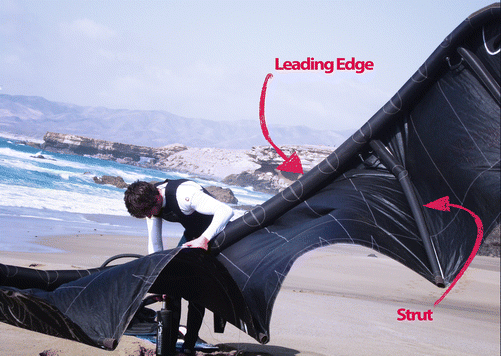
Fig. 15.2
Inflating a leading edge inflatable kite using a hand pump. La Pared, Fuerteventura
Most kites used in kiteboarding measure between 5 and 20 m2. Smaller kites can be used in snowkiting given the same wind conditions since the quota of energy needed to keep the kiter afloat and ride the waves is not required. The length of the lines varies between 20 and 30 m with a thickness of just a few millimeters and a load capacity of approximately 200 kg each. The two lines attached to the two sides of the leading edge are known as front lines and transfer the power of the kite directly to the kiter by way of the chicken loop, a loop device hooked into the kitesurfing harness. The chicken loop forms a semi-permanent attachment between the kite and the kiter; it can be unhooked for special freestyle maneuvers and allows a rapid release for safety reasons (Fig. 15.3
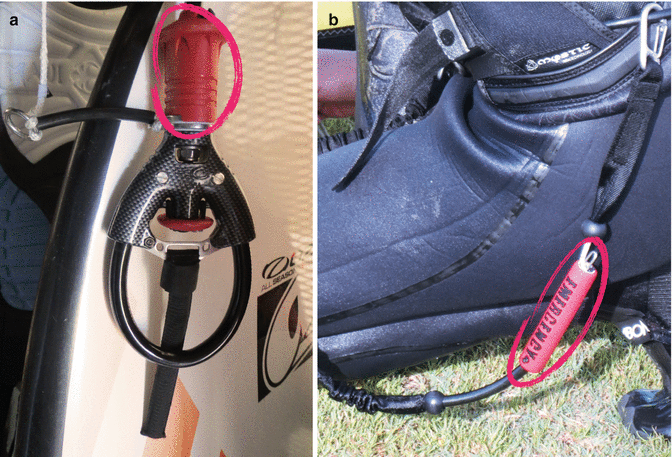
). The lines attached to the two trailing edges of the kite (back lines) are connected directly to the handlebar, a tubular structure normally in carbon fiber measuring 45–55 cm in length used to steer the kite (Fig. 15.4
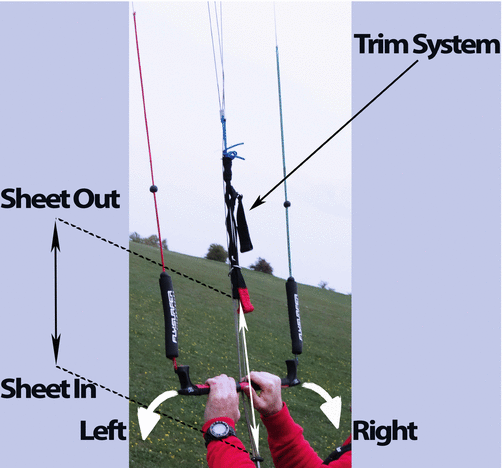
). Although most traction kites have four lines, some leading inflatable edges have an extra line. This helps maintain the profile of the wing in flight, acts as a safety system, and makes it easier to relaunch in the event of a fall in water.

Fig. 15.3
Safety systems. The chicken loop is fitted with a rapid-release system (a), allowing the kiter to immediately detach himself from the kite in the event of an incident. This causes the kite to deflate and lose power. A leash keeps the kite connected to the kiter and helps de-power the kite completely. The leash is also fitted with its own quick-release system (b), allowing the kiter to detach himself from the deflated kite if necessary

Fig. 15.4
Use and operation of the handlebar. By pulling one side of the bar towards himself, the kiter increases the tension on one of the back lines steering the kite to that side. By pulling the whole bar towards himself, tension is increased on both back lines reducing the angle of incidence of the wind on the kite and increasing the power supplied. A trim system set between the front lines and chicken loop allows the kiter to make fine adjustments in the angle of incidence of the wind on the wing adapting the kite to accommodate for small changes in wind strength
15.1.1.2 Harnesses
Different models of harness are available including waist (Fig. 15.5
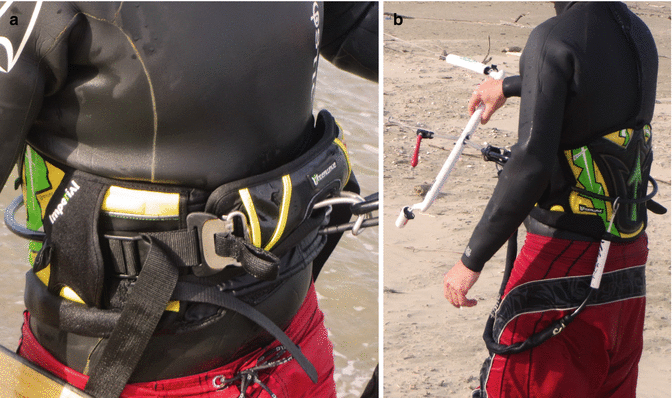
) and seat types. The choice of harness depends on the discipline practiced and on individual preferences. Seat harnesses have a lower tow point. This lends itself to greater stability which in turn allows easier water starts, however they tend to be bulkier and reduce freedom of movement. In addition, the seat-type is fitted with leg loops preventing it from being pulled up the kiter’s body and causing discomfort (as can happen with waist-type harnesses). Combo harnesses combine the advantages of waist and seat harnesses. Their shape is similar to waist-type harnesses with the addition of the leg loops typical of seat-type harnesses.

Fig. 15.5
Power-kiting harness (waist type). (a) Anterolateral view. (b) Posterolateral view. Harnesses have a steel hook connected to a robust system of straps that distribute the forces to the kiter’s body
15.2 Kitesurfing
15.2.1 Disciplines and Kiteboards
Modern kiteboarding features a number of different disciplines (Table 15.1
), and the kiteboards used change depending on the kind of performance required and the rider’s style.
Table 15.1
Main kiteboarding disciplines
Style | Description |
|---|---|
Course racing | Similar to yacht racing, this discipline involves racing events along a course, and requires both speed and tactics [4] |
Free-ride | An amateur-style discipline, which includes crossing, improvised tricks, and maneuvers of various kinds that are chosen by the rider |
Freestyle | This consists of a rider performing jumps, maneuvers, and evolutions of varying technical complexity. Being the “mother” discipline of kitesurfing, it is constantly evolving, and consists of two main styles: known as old school and new school. Old school was the first style practiced in kitesurfing, it consists of mainly “hooked” evolutions, characterized by high jumps with long phases of flight. New school involves tricks and aerials borrowed from wakeboarding, generally performed with the kite unhooked and at full power |
Speed racing | In this discipline the kiter aims to complete a 250 or 500 m course in the fastest time possible, setting speed records with the aid of GPS units |
Wave riding | Wave riding combines kiteboarding with surfing; it is practiced using strapless surfboards or specific directional kiteboards |
Being more versatile and simpler to use, twin-tip boards are the most common type of kiteboard. They derive from wakeboarding and are small and narrow; most measure between 120 and 165 cm in length and between 30 and 46 cm in width. Their symmetrical shape allows the rider to change direction of travel without changing stance on the board, and they are particularly suited to freestyle, free -ride and wakestyle. Directional boards travel in one direction only and require a maneuver (tack or jibe) to change orientation. Deriving from windsurfing boards, they are larger than twin-tip boards: they may reach 190 cm in length and 70 cm in width [5]. They are preferred in course racing where their large fins and greater float are used to achieve optimal upwind angles and keep the board gliding even if the wind drops. They are also used for wave riding (Fig. 15.6) where their higher volume and rideability allow the kiter to better interact with the hydrodynamic forces of the waves. A recent innovation in course race board manufacturing has seen the introduction of foil technology where the reduced area of contact with water results in even greater speeds. Skimboards are highly technical directional boards mainly used for free riding or wave riding without straps or fins. The discipline of speed racing uses special asymmetric, directional boards – narrow, elongated, and extremely rigid ones. Mutant boards have a preferential direction of travel, but they can also travel in the opposite direction. Being built for various purposes, they are mainly used in wave riding.


Fig. 15.6
Wave riding in Cape Verde. Rider: Airton Cozzolino. Directional boards are preferred in wave riding: one end is triangular and acts as a prow while the other is wider and fitted with fins (Photo courtesy of Claudio Marosa)
Most twin-tip boards come with four small fins, two at each end. Directional boards normally have three larger fins at the stern, while those used with fixed structures (kickers or jumps) in wakestyle have no fins attached. The feet are usually fixed to the board by way of sandal-type foot straps, similar to but wider than those used in windsurfing, allowing the feet to be removed quickly from the board as required for certain maneuvers. Bindings are shoe-type attachments that are used particularly in wakestyle by expert riders, while strapless boards are used by some kiters especially in wave riding.
15.3 Kiteboarding Physiology
The study of kiteboarding physiology is difficult due to many factors involved and the fact that the physical demands required are progressively evolving with the diversification of the various disciplines; indeed, there are huge differences between crossing (simply gliding on the water crosswind) and freestyle.
During crossing with a normal twin-tip board, the rider is attached to the kite and leans backwards towards the water with the upper part of the body facing the direction of travel to balance the traction of the kite (Fig. 15.7
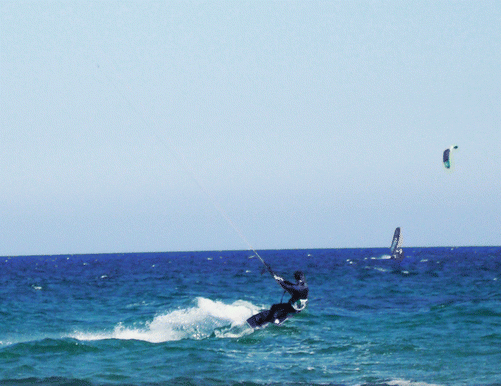
). The knees maintain an angle of between 135° and 150° while the elbow remains bent at approximately 90° to exert the traction on the handlebar needed to maintain an adequate tension of the back lines. In this position, the towing force of the kite on the waist keeps the lumbar spine in hyperextension, and the abdominal muscles perform an isometric effort to counteract lordosis. On the other hand, the effort performed by thigh muscles to counteract the push of the water against the board is prevalently isometric, but it is interrupted by the small flexion and extension movements of the hips and knees required to follow the waves and adjust the course in response to changes in wind direction and strength.

Fig. 15.7
Kitesurfing crossing
Vercruyssen et al. [6] estimated the physiological demands of crossing based on heart rate (HR) taking it as an estimation of the VO2 and measuring the blood lactate concentration (Lab). The physical effort involved in kitesurfing, similarly to that required in Laser sailing, is characterized by considerable increases in HR and blood pressure, maybe because the isometric contraction of large muscle masses limits blood supply due to the compression of blood vessels by muscle fibers. At the same time, however, low values of Lab were found. The discontinuous nature of isometric effort due to the associated dynamic movements required during kiteboarding actually allows the muscles to rest, reducing the sensation of fatigue or preventing its onset [7]. Despite this, the fatigue resulting from an average 30–40 min course racing session may be significant to the extent of affecting performance [8, 9], therefore an adequate level of athletic preparation is essential for those who wish to compete. Overall, when done in light winds (12–15 knots), crossing is a prevalently aerobic effort. Energy expenditure during crossing can be favorably compared with Laser sailing and windsurfing, resulting in a moderately intense activity with an average HR in the range of 72–85 % of the maximum HR. The beginning of the glide requires a greater expenditure of energy since more effort is necessary to position the board correctly on the water and manage the kite. After a few minutes, the HR stabilizes at slightly lower levels, probably due to the kiter’s ability to assume the most comfortable position once the board has begun to glide over the water, optimizing the efficiency of the kitesurf at the same time.
Various tricks are performed during freestyle such as jumps and maneuvers. Jumps can be performed by pushing with the legs as in wakeboarding, using a wave as a trampoline as in windsurfing, or using the lift of the kite. The latter technique permits spectacular jump maneuvers and is typical of kiteboarding. To use the lift of the kite, the jump is prepared by maximizing the tension on the lines which is done by directing the board into the wind during crossing. In this phase, the isometric effort performed by the kiter increases considerably, and many kiters report irritation or pain in the joints of the lower limbs and the abdominal muscles during this initial phase of more demanding jumps [8, 9] (Fig. 15.8
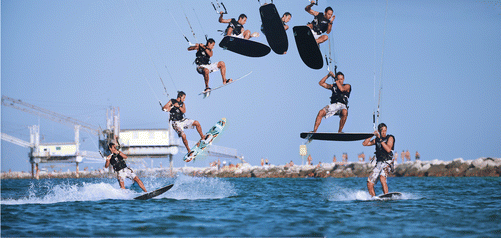
). A slight flexion of the hips is also required to prepare the slight push needed to help the rider take off from the surface of the water [8]. The jump begins when kiters suddenly invert the direction of flight of the kite, abruptly discharging the energy accumulated in the previous phase towards the zenith, which lifts them into the air.

Fig. 15.8
Rider: Marco Tagliaferri. Location: Porto Corsini, Ravenna, Italy. A jump using the lift of the kite – explanation in the text (Photo: Roberto Mori)
The jump can lift the kiter to a height of several meters, and the flight phases can last several seconds. Various types of tricks can then be performed during the hang time such as horizontal and vertical rotations or grabs with particular positions of the body. The sequences of movements executed during this phase are similar to those of gymnastics including extension of the limbs and bust, crouches and flexion of the limbs and torso, and grasping of the board – all involving different types of physical effort. The descent phase is slow, and the kiter exploits the parachute effect of the kite by modifying the tension on the lines. During landing, the legs bend and absorb part of the impact while the vertical deceleration of the body is partly neutralized by the upward traction of the kite which resumes its flight in the original direction. The effort of the postural muscles, especially those of the back and the abdomen, allow the body to take up the correct position for landing, while the lower limb muscles contract during landing.
Overall, freestyle is an intense activity involving both aerobic and anaerobic metabolisms. During a freestyle event in mid-wind conditions (ranging from 15 to 22 knots), the average HR was quantified as 85.4 ± 3.0 % of the maximum HR, and VO2 values were estimated as 80.0 ± 4.5 % of the maximum oxygen uptake, while mid-values for Lab of 5.2 ± 0.8 % mmol/L were observed at the end of the freestyle trial [10].
15.3.1 Unhooked Maneuvers
To perform particular acrobatic freestyle tricks, the kiter can unhook the chicken loop while remaining temporarily attached to the kite only by his grip on the bar. These maneuvers require an intense effort on the part of the kiter to maintain his grip on the bar, steer the kite, and perform the desired tricks at the same time, all placing the shoulders and elbows under particular strain. In addition, by unhooking the kite from the harness, the point where the wind force acts on the kiter moves with respect to his center of gravity. As a consequence, an unhooked kiter is unable to lean back and counteract the pull of the kiter by applying more pressure on the back edge of the board, but tends to be dragged downwind by the kite. For this reason, in order to maintain sufficient tension on the lines to steer the kite, the athlete must increase the power supplied by flying the kite lower, near the center of the wind window (power zone; Figs. 15.9 and 15.10
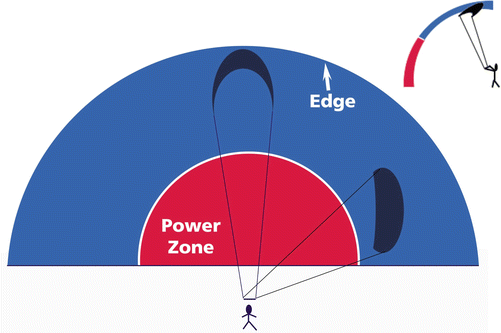
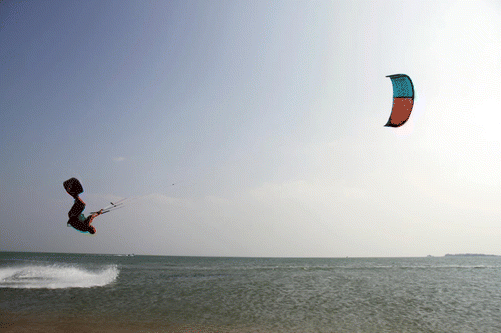
). This means that during unhooked maneuvers, the traction of the kite has a greater tangential component with respect to the surface of the water making landings during unhooked maneuvers much more demanding and traumatic than hooked performances.

Fig. 15.9
Wind window. The kite always flies in an area of the sky that is shaped like a quarter of a sphere, downwind from the kiter: the wind window. The upwind edge of the wind window is shaped like a semicircle, which passes over the rider’s head at an angle of 90° with respect to the direction of the wind. This is a neutral area. The closer the kite is to the center of the wind window, the more the incidence of the wind on the wing approaches 90°, and the greater the power generated by the kite, the maximum power being obtained when the kite is at the center of the window exactly downwind of the rider, the area known as the power zone

Fig. 15.10
Rider: Fabio Ingrosso. Unhooked maneuvers. Unhooked maneuvers are practiced by very skilled kiters. Unhooking the kite from the harness allows the freedom of movement necessary to perform more extreme maneuvers. During unhooked maneuvers, the kite is at a lower angle from the; surface of the water it is approximately 45° compared to 60° or more during hooked maneuvers (Photo courtesy of Fabio Ingrosso)
15.4 Acute Injuries
15.4.1 Injury Rates
A review of the literature reveals a wide range of injury rates depending on study design, the different skill levels of the participants, and the discipline practiced [9]. Nickel et al. [11] in their prospective study defined an injury as “any damage to the body that resulted in incapacity to practice or compete normally,” finding an overall injury rate of 7 per 1000 h of practice. The risk of injury was 2.5 times higher during competition than during practice, reaching values of 16.6 injuries per 1000 h. Among professional kiters taking part in the World Cup Fuerteventura 2008, Pérez-Turpin et al. [12] found that most of the injuries sustained during competition (66.7 %) caused more than 1 week of inactivity, while only about one third (34.5 %) of those sustained during training required more than 1 week of rest. In the same study, many more injuries were sustained in the discipline of course racing (68.4 %) than in freestyle (31.6 %). In wakestyle, the risk of injury is higher since maneuvers are performed at high speed and often involve various rotations of the body with possible loss of kite and board control [3].
Wegner and Wegener [13] reported significantly more injuries among inexperienced kitesurfers compared to more expert kiters. In addition they described a trend whereby the rate of injuries decreased constantly as skill level increased (from 30.9 to 6.1 injuries/1000 h), but also that expert kiters sustained more serious injuries. It is probable that the technological progress made in equipment manufacturing has modified both the rate and type of injuries over time. In this regard, Kristen et al. [3] in their study on the injuries sustained in the Kitesurf World Cup event in Podersdorf (Austria) between 2002 and 2013 found that the rate of severe injuries during competition decreased over the period studied, while the rate of mild injuries, those which allowed the athletes to continue competing, remained stable.
15.4.2 Most Common Injuries
According to Nickel et al. [11], 77 % of the injuries were mild, i.e., affecting the capacity to train or compete normally but without resulting in absence from practice. Nineteen percent of injuries were classified as medium (causing absence from practice for more than 1 day), three percent were severe (leading to absence from practice for more than 6 weeks), and only one was catastrophic. In the same series, out of 124 injuries, 53.2 % were to the lower limbs, 16.9 % to the upper limbs, 16.1 % to the trunk, and 13.7 % to the head. A similar distribution was found in other studies [8, 14, 15]. Nickel et al. [11] also found the ankle and foot to be the most commonly injured region of the body (28 %; n = 35), sustaining injuries mainly consisting of sprains of the ankle ligaments but also including fractures of the ankle and the fifth metatarsal bone. Knee injuries were also common (12.9 %; n = 16) and were mainly represented by ACL, PCL and medial collateral ligament tears. Thoracic injuries included contusions and rib fractures, while the most common type of injuries to the head were lacerations, although contusions associated with concussion and with nasal hematoma were also noted. Severe maxillofacial trauma and eardrum, tooth, and eye injuries have been reported in other studies [14, 16]. More recently, Pérez-Turpin et al. [12] examined an elite group of kitesurfers finding that the ankle joint was affected in 61 % of cases followed by the foot (13 %) and knee (11 %), while only five percent of injuries were to the upper extremities and trunk.
Stay updated, free articles. Join our Telegram channel

Full access? Get Clinical Tree








